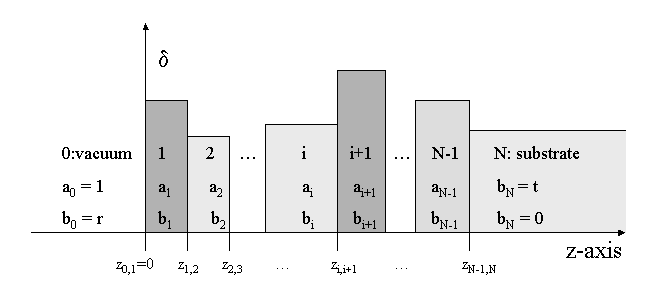
A typical application of a reflectivity measurement is, if we have a
thin
film on a substrate. Now we have to deal with two interfaces, air-film and film-substrate. We expect that
the
reflected wave from both interfaces interfere with each other and give rise to Kiessig fringes, from which
the
thickness of the film can be determined with high precision. We will
treat
the most general case now where we have n interfaces and the goal is,
to
understand how to solve the system of 2N boundary conditions.

Within each region i we have a wave vector kz,i as given by
the
local index of refraction, and amplitudes ai and bi
of the incident and the reflected waves, respectively. For the
interface between
layer i and layer i+1 at a distance zi,i+1 from the top
surface
at z0,1=0 and wave vectors kz,i+1 and kz,i
on either side of the boundary, we get the following boundary condition
for
the wave amplitudes:
ai exp(i kz,i zi,i+1) + bi exp(-i kz,i zi,i+1) = ai+1 exp(i kz,i+1 zi,i+1) + bi+1 exp(-i kz,i+1 zi,i+1)and with some re-arranging
kz,i ai exp(i kz,i zi,i+1) - kz,i bi exp(-i kz,i zi,i+1) = kz,i+1 ai+1 exp(i kz,i+1 zi,i+1) - kz,i+1 bi+1 exp(-i kz,i+1 zi,i+1)
ai = Ai,i+1,11 ai+1 + Ai,i+1,12 bi+1i.e. the transfer matrix Ai,i+1 relates the fields on either side of the interface i,i+1.
bi = Ai,i+1,21 ai+1 + Ai,i+1,22 bi+1
homework: calculate the components of the 2×2 matrix Ai,i+1
For the whole stack of N layers we thus get
(a0, b0) = A0,1 A1,2 ... Ai,i+1 ... AN-1,N (aN, bN) = A (aN, bN)a0,b0 and aN,bN are special: a0 is just the incident wave onto the sample, b0 yields the reflectivity signal we
a0 = 1We assume an infinitely thick substrate, so there is no reflected wave in layer N:
b0 = r
bN = 0and aN is the transmitted wave into the substrate. Hence we arrive at
(1, r) = A (t, 0)which can be easily solved now for r and t
t = 1 / A11We see that the general case involves more or less the same amount of calculation as the special cases of one or two layers. The outlined algorithm is known as the "matrix method" and is the algorithm mostly used these days.
r = A21 / A11
Note, that the matrix formalism has a direct analogon in quantum
mechanics, namely reflection and transmission of a particle wave at a
potential step or barrier (tunnel effect!). The requirement of
continuity of the wave function ψ and its derivative at the
potential step gives
rise to the same boundary conditions as above. With respect to
application
in scattering, the quantum mechanical case is of importance for
reflectivity
studies with neutron beams.